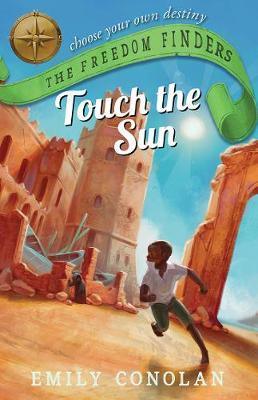Emily Conolan, Break Your Chains (The Freedom Fighters #1), Allen & Unwin, 28 March 2018, 144pp., $16.99 (pbk), ISBN: 9781760294915
Emily Conolan, Touch the Sun (The Freedom Fighters #2), Allen & Unwin, 28 March 2018, 144pp., $16.99 (pbk), ISBN: 9781760294922
The Freedom Fighters series is, hopefully, going to start a lot of conversations. These books tell stories about young people, children from different times and places, coming to Australia under desperate circumstances. Emily Conolan tells these stories with intelligence, cleverness and sensitivity.
I’m not normally a big fan of the Choose Your Own Adventure books, but it turns out that this format is perfect for what Conolan is trying to achieve with this series. The choose your own format encourages empathy and understanding in the reader by putting us in the shoes of the protagonist. The events happen to ‘You, the reader’, and it is the reader’s own choices that lead to a better life and freedom, or dire consequences. This format very cleverly gets us to examine what choices we would make under these circumstances, to understand that often there are no ‘good’ choices, and sometimes the book makes the point that the protagonist has no choice at all in the direction events take.
These books are beautifully written and descriptive. It’s not hard to feel yourself in the middle of the action. In Break Your Chains, the reader is put into the shoes of a young Irish girl on the streets of London in 1825. If she survives the many dangers around her, from smallpox and starvation, to being jailed and deported to Australia for thieving, she’ll face grueling work, bushrangers and fire before she has a hope of winning her freedom and maybe finding her Da again.
Touch the Sun, on the other hand, is the story of a young boy growing up in 2011 with his sister and journalist aunt in war-torn Somalia. He has dreams of becoming a journalist, like his aunt, but will he manage to escape the terrorist organisation hunting his family and make the terrifying journey across the ocean in search of safety and freedom in Australia?
This series is not light and easy to read. Many of the possible paths lead to the protagonist’s death, and things can get confronting and upsetting. But Conolan acknowledges the difficult subjects she’s writing about, and handles them with great sensitivity. Each book includes a foreword that warns that the reader is going to find some things distressing and may need to talk to a trusted adult, and that the choices they make may not work out well for them. Conolan also talks about the difficulties and choices she faced as a writer in tackling controversial subjects.
Conolan is a teacher and writer who has worked extensively with asylum seekers in Tasmania, and has been recognised for her humanitarian work. The research and understanding really shines through in these books. I appreciated the fact files included at the end of the books, giving supporting information – from a brief outline of Somalia and facts about journalists at risk and people smugglers, to child labour in England and convicts in Van Diemen’s Land. Throughout the stories, the reader is sometimes prompted to go to these fact files to seek more information to inform their choices. The level of research behind these books is thoughtful, and thought-provoking.
Conolan has consulted with a number of sources to create these books and give the stories a veracity and depth. Touch the Sun is informed by the stories of many asylum seekers Conolan has spoken to, including Hani Abdile, a poet who travelled from Somalia to Australia. Conolan has included an interview with Abdile in the notes at the end of Touch the Sun. In Break Your Chains, Conolan worked with Theresa Sainty, a Tasmanian Aboriginal Elder, who gave permission for use of the various palawa kani words used, and advised Conolan on the history of the Aboriginal tribes that lived in that area.
All in all, these books are a complete package for the right reader of 11 and up, or for opening up classroom discussion. They include fantastic, compellingly told stories that make a vivid point about what choices the reader might make in dire circumstances. They offer a sensitive and thoughtful discussion of the role of the writer in telling these stories. And the notes at the end of the books cover further historical information, interviews that add context to the story, and, in the case of Touch the Sun, further internet resources that the reader can follow up. I also liked that Break Your Chains included a section that discussed exactly where and how Conolan used artistic license in the history she writes about.
I followed each story through many possible choices. I died more than a few times. And it was hard to fight through to the happy ending. But I hope many other readers will read these stories and the thoughtful information Conolan has supported them with, and walk away with a lot to think about and much to talk about.
Reviewed by Emily Clarke


